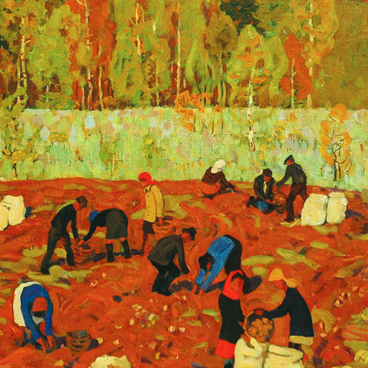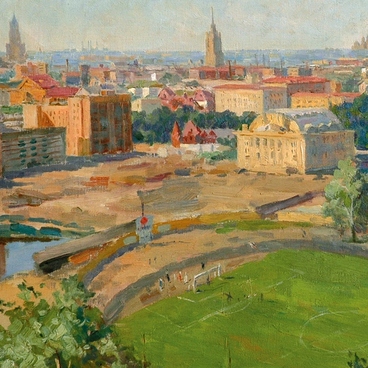Nikolai Nikolaevich Solomin was born in Moscow in 1940. Nikolai Solomin’s father was People’s Artist of the RSFSR Nikolai Konstantinovich Solomin. During the war, his father was sent to the front. As circumstances would have it, little Nikolai stayed with his mother in Leningrad after the war, and visited his father in Moscow in the summer and stayed at the country house or in village, where he began to draw. The younger Nikolai matriculated at the Surikov Institute Art School. Then in 1965 he graduated from the V. Surikov Moscow State Academy Art Institute.
His father taught at the art school and young Solomin began to study painting in his class. In an attempt to get away from the pressure of his father’s authority, he decided after some time to transfer to another teacher’s class. After graduation, father and son worked in the same studio for a short time. However, Solomin decided to leave his father’s workshop in search of his own style. He found himself for real in the Grekov Studio of Military Artists, where he ended up in 1969. While working there, he went to serve in the army. The artist repeatedly found himself in hot spots, including in Afghanistan and Chechnya. Solomin grew as a battle painter during his missions and rose to the rank of colonel.
From 1989 to 1997, the artist was head of the Grekov studio. From 1995 to 2000 he participated in painting murals in the reconstructed Cathedral of Christ the Savior. In 2005, he began teaching in the Department of Historical and Battle Painting at the Surikov Institute.
In Solomin’s work, battle scenes co-exist with pictures of peaceful life: portraits of children, still lifes, and landscapes. The artist often paints children. In his works, their images are always lively and direct: they are swimming or fishing in the river, playing with animals, relaxing in nature, busy with books or toys. The works do not look staged; they are like a snapshot from life, extracted by the attentive gaze of the artist.
All of these features are present in the picture Tales. It depicts the simple and familiar atmosphere of a Soviet household. A girl is discussing a tale she has just read with her mother; a bouquet of bright red flowers is standing on the table; warm sunlight shines into the room through the large window. The artist delights in this simple setting and with it captivates the viewer.
His father taught at the art school and young Solomin began to study painting in his class. In an attempt to get away from the pressure of his father’s authority, he decided after some time to transfer to another teacher’s class. After graduation, father and son worked in the same studio for a short time. However, Solomin decided to leave his father’s workshop in search of his own style. He found himself for real in the Grekov Studio of Military Artists, where he ended up in 1969. While working there, he went to serve in the army. The artist repeatedly found himself in hot spots, including in Afghanistan and Chechnya. Solomin grew as a battle painter during his missions and rose to the rank of colonel.
From 1989 to 1997, the artist was head of the Grekov studio. From 1995 to 2000 he participated in painting murals in the reconstructed Cathedral of Christ the Savior. In 2005, he began teaching in the Department of Historical and Battle Painting at the Surikov Institute.
In Solomin’s work, battle scenes co-exist with pictures of peaceful life: portraits of children, still lifes, and landscapes. The artist often paints children. In his works, their images are always lively and direct: they are swimming or fishing in the river, playing with animals, relaxing in nature, busy with books or toys. The works do not look staged; they are like a snapshot from life, extracted by the attentive gaze of the artist.
All of these features are present in the picture Tales. It depicts the simple and familiar atmosphere of a Soviet household. A girl is discussing a tale she has just read with her mother; a bouquet of bright red flowers is standing on the table; warm sunlight shines into the room through the large window. The artist delights in this simple setting and with it captivates the viewer.




